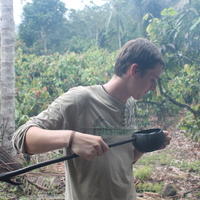- Ethnobotany, Ethnobotany, Ethnobiology, Ethnoecology, Non Timber Forest Products (NTFP), Biodiversity, Climate Change, medicinal & Aromatic plants, and 16 moreThreatened Plants, Agrodiversity, Agroforestry, agroforestry and NTFPs, Herbal Medicine, Phytotherapy, Medicinal Plants, Sustainable agriculture, Food and Nutrition, Indigenous Knowledge, Anthropology, Social and Cultural Anthropology, Ethnobiology, Hunter-Gatherers (Anthropology), Social Research Methods and Methodology, and Indigenous ecological knowledges and practicesedit
Multistrata agroforests comprise a wide range of agroforestry practices that includes assemblage of woody and nonwoody plant components, with the wide range of practices on the continuum from using shade trees in perennial plantation to... more
Multistrata agroforests comprise a wide range of agroforestry practices that includes assemblage of woody and nonwoody plant components, with the wide range of practices on the continuum from using shade trees in perennial plantation to very diversified agroforests that mimic the original forest-like structure. In the humid tropical lowlands, such systems often consist of cocoa (Theobroma cacao) grown under the shade of trees. In this review, we explore the reliability of research on and the feasibility of achieving the environmental and economic benefits of cocoa agro-forests, highlighting future opportunities and challenges of cocoa growing. Unsustainable intensification in a form of monocultures with high agricultural inputs reduces ecological resilience of a land-use system, whereas paradoxically, environmental and climate changes require more than ever a higher capacity of land-use systems to cope with increasing global environmental pressure. Over the past decade, a number of new studies focusing on cocoa agroforests have been published. We review current cultivation of cocoa in the world and outline the establishment and management of cocoa agroforests. Further on, we explored the idea that cocoa agro-B. Lojka (*) · L. Pawera · V. Verner 588 forests could be a solution to prevent phenomenon of boom-and-bust cycle of cocoa cultivation and highlighted the possibilities for improvement of cocoa cultivation using its vast genetic base. Then the benefits of cocoa agroforests for (agro)biodiver-sity and soil conservation are summarized and economic perspectives of multistrata systems assessed. In final discussion, we performed a SWOT analysis, highlighting future opportunities and challenges and proposing recommendation to improve the extension, adoption and sustainability of cocoa agroforests. Keywords Agrobiodiversity · Cocoa farming · Genetic diversity · Soil management · SWOT analysis · Theobroma cacao
Research Interests:
Chapter in handbook for implementation of Czech development projects related to development goal 2 - Food security. The linkages of food, malnutrition and hidden hunger - The potential of food plants and local knowledge - Crop... more
Chapter in handbook for implementation of Czech development projects related to development goal 2 - Food security. The linkages of food, malnutrition and hidden hunger
- The potential of food plants and local knowledge
- Crop interspecific diversity and its overlooked importance
- The role of agrobiodiversity in nutrition-sensitive agriculture and in the human diet
- Informal seed systems and development of community seedbanks
- The potential of food plants and local knowledge
- Crop interspecific diversity and its overlooked importance
- The role of agrobiodiversity in nutrition-sensitive agriculture and in the human diet
- Informal seed systems and development of community seedbanks
